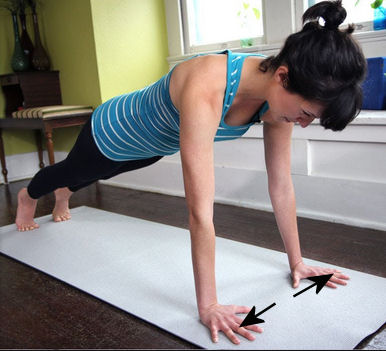Yoga & Meditation
| Yoga: Foundations of Asana (Posture) |
|
This page provides key points on asana practice. BreathThe breath is the your barometer. The posture should always be effortful, but it should be stable which means the breath should be even and smooth. Characteristics of the Breath for BeginnersDuring asana the breath should be:
Action vs MovementIn yoga, action is different than movement. An action is a muscular contraction that stabilizes or directs the energy of the posture to a specific area(s) of the body. A movement is realigning (moving) a body part such as an arm, leg, torso, or head to a different position in space. For example, lifting an arm from the waist to shoulder height is a movement. An example of an action with a movement is lifting bending the back in cobra and dropping the tailbone down the the heels while lifting the pit of the abdomen. Extension and Alignment vs Range of Motion (ROM)In my opinion, ROM is over emphasized especially with beginners. It is more important to be in alignment. Alignment creates the structure that supports the bones, joints, muscles, and organs. It also enables the energy of the posture to flow where it is supposed to flow. General Alignment PrinciplesFrom my point of view, asanas (postures) are "attitudes" to be expressed, not postures to be held. You and the asana are in a constant coordinated "dance" of awareness and alignment. Alignment in the posture ensures that the posture provides the maximum benefit to you. Foot AlignmentBKS Iynenger states that all postures should be performed as if you were standing on the ground, so most postures are performed with flat (as opposed to pointed) feet. In standing poses the feet are pressing down with both ball mounds and both sides of the heels. In sitting postures the feet are still flat and you extend through your heels. Exercise:While standing, press down with the ball mounds of your big toes and little toes and inner and outer heels. Then lift all your toes and feel the arches of your feet lift. Leg AlignmentStanding postures are performed with the legs straight, but not locked. The knee caps are almost always over the middle toe of the foot. In bent leg postures, the legs are almost always parallel so the the knees are over, as opposed to past, the feet as in lunges.
KneesAs stated above, the knees are never locked. The technique to strengthen the muscles around the knee is to "lift" the knee cap by contracting the thigh muscles. Exercise for lifting knee capsSit on floor with legs straight out. For nine (9) breaths, on each exhalation contract the thigh muscles, and on every inhalation relax. Hint: On each exhalation contract thigh muscles, but don't lock your legs. Pelvic Activation and AlignmentOne of the actions of postures is to direct energy to where it is needed. Like Pilates, yoga works on the "core." The middle section of the body that includes the abdominal, hip, and erector spinae muscles. Activating the core intelligently saves the lower back from excess strain, but also enables the posture to "weave" around the spine. To keep the core activated and lower back safe, follow these two actions shown in this figure:
 Exercise: Back FlatteningLie on your back with your knees bent and breathe out through pursed lips to bring your rib cage to your pelvic bones (this will flatten your back to the floor). Perform a passive inhalation still keeping your lower back to the floor. Next, with knees bent, exhale through pursed lips and stretch your right leg along the floor keeping your back on the floor. Passive inhalation bringing your right leg back to start position keeping your back against the wall. Repeat with the left leg. Working with the CoreIf you go to an fitness class, chances are that you will hear the instructor talk about exercises for the "core." The core is defined as a set of 4 abdominal muscles and 3 sets of back (erector spinae) muscles that surround and support the torso (trunk). These muscles support the spine and organs in this region. In yoga, lifting the pit of the abdomen (see pelvic alignment) and dropping the tailbone activate the core muscles as well as proper breathing. Shoulder AlignmentThe shoulder joints and surrounding muscles are one of the most "overused" parts of the body. One reason is that the shoulders, along with the face, are the 'expressive" parts of the body. When performing yoga postures, keep the shoulders released so that the shoulder blades can slide down the back and away from the spine. This action release tension from the neck and support the shoulder girdle, which in turn, decreses the risk of shoulder injury (rotator cuff). In additon, activate the seratus anterior by using the action (see actions vs movements). Exercise for activating the serratus anterior:
Shoulder alignment is extremely important when performing postures such as plank, upward facing dog, and various arm balances. Hand PositionReferring to the image above, notice that the practicioner's hands are straight ahead (middle finger pointing straight ahead) and that the fingers are spread. The weight of the body is distributed through the webbing of the thumb and first finger. The wrists to take the weight of the body without injury. Alterante hand positions and the use of props can be used if there are wrist issues. Use these principles as you practice the Beginner's Yoga Routine
|

